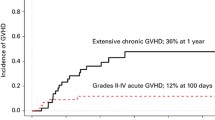Abstract
Despite high-dose chemotherapy and autografting, the outcome for patients with primary refractory Hodgkin’s disease (HD) or multiple relapses remains unsatisfactory. Six pediatric patients (median age: 16 years, range: 11–19) received reduced intensity conditioning and allogeneic peripheral blood stem cell transplantation (PBSCT) after failure of stratified first-line chemotherapy, involved-field radiotherapy, and salvage chemotherapy including autologous PBSCT (two patients). For conditioning, fludarabine was combined with busulfan (8 or 12 mg/kg) and additional cyclophosphamide (three patients), or without cyclophosphamide (two patients), or melphalan (one patient). Two patients died of infections and one of progression. One patient remains in complete remission 59 months following transplantation. Two patients relapsed but responded after withdrawal of immunosuppression, chemotherapy, or donor lymphocyte infusions and are alive at 22 and 36 months post transplant, respectively. Allogeneic PBSCT, with reduced intensity conditioning, may be beneficial for selected patients with refractory HD.
Similar content being viewed by others
References
Akpek G, Ambinder RF, Piantadosi S, Abrams RA, Brodsky RA, Vogelsang GB, Zahurak ML, Fuller D, Miller CB, Noga SJ, Fuchs E, Flinn IW, O’Donnell P, Seifter EJ, Mann RB, Jones RJ (2001) Long-term results of blood and marrow transplantation for Hodgkin’s lymphoma. J Clin Oncol 19:4314–4321
Anderlini P, Giralt S, Andersson B, Ueno NT, Khouri I, Acholonu S, Cohen A, Korbling MJ, Manning J, Romaguera J, Sarris A, Rodriguez MA, Hagemeister F, Mclaughlin P, Cabanillas F, Champlin RE (2000) Allogeneic stem cell transplantation with fludarabine-based, less intensive conditioning regimens as adoptive immunotherapy in advanced Hodgkin’s disease. Bone Marrow Transplant 26:615–620
Anderson JE, Litzow MR, Appelbaum FR, Schoch G, Fisher LD, Buckner CD, Petersen FB, Crawford SW, Press OW, Sanders JE, Bensinger WI, Martin PJ, Storb R, Sullivan KM, Hansen JA, Thomas ED (1993) Allogeneic, syngeneic, and autologous marrow transplantation for Hodgkin’s disease: the 21-year Seattle experience. J Clin Oncol 11:2342–2350
Carella AM, Cavaliere M, Lerma E, Ferrara R, Tedeschi L, Romanelli A, Vinci M, Pinotti G, Lambelet P, Loni C, Verdiani S, De Stefano F, Valbonesi M, Corsetti MT (2000) Autografting followed by nonmyeloablative immunosuppressive chemotherapy and allogeneic peripheral-blood hematopoietic stem-cell transplantation as treatment of resistant Hodgkin’s disease and non-Hodgkin’s lymphoma. J Clin Oncol 18:3918–3924
Claviez A, Boogaerts MA, Slavin S, Pession A, Bosi A, Carella AM, Izzi T, Schmitz N (2002) Allogeneic hematopoietic stem cell transplantation in children and adolescents with Hodgkin’s disease: an EBMT analysis. Bone Marrow Transplant 29 [Suppl 2]:10a
Corradini P, Tarella C, Olivieri A, Gianni AM, Voena C, Zallio F, Ladetto M, Falda M, Lucesole M, Dodero A, Ciceri F, Benedetti F, Rambaldi A, Sajeva MR, Tresoldi M, Pileri A, Bordignon C, Bregni M (2002) Reduced-intensity conditioning followed by allografting of hematopoietic cells can produce clinical and molecular remissions in patients with poor-risk hematologic malignancies. Blood 99:75–82
Dann EJ, Daugherty CK, Larson RA (1997) Allogeneic bone marrow transplantation for relapsed and refractory Hodgkin’s disease and non-Hodgkin’s lymphoma. Bone Marrow Transplant 20:369–374
Dörffel W, Lüders H, Rühl U, Albrecht M, Marciniak H, Parwaresch R, Pötter R, Schellong G, Schwarze EW, Wickmann L (2003) Preliminary results of the multicenter trial GPOH-HD 95 for the treatment of Hodgkin’s disease in children and adolescents: analysis and outlook. Klin Pädiatr 215:139–145
Gajewski JL, Phillips GL, Sobocinski KA, Armitage JO, Gale RP, Champlin RE, Herzig RH, Hurd DD, Jagannath S, Klein JP, Lazarus HM, McCarthy PL Jr, Pavlovsky S, Peterson FB, Rowlings PA, Russell JA, Silver SM, Vose JM, Wiernik PH, Bortin MM, Horowitz MM (1996) Bone marrow transplants from HLA-identical siblings in advanced Hodgkin’s disease. J Clin Oncol 14:572–578
Jones RJ, Ambinder RF, Piantadosi S, Santos GW (1991) Evidence of a graft-versus-lymphoma effect associated with allogeneic bone marrow transplantation. Blood 77:649–653
Kottaridis PD, Milligan DW, Chopra R, Chakraverty RK, Chakrabarti S, Robinson S, Peggs K, Verfuerth S, Pettengell R, Marsh JC, Schey S, Mahendra P, Morgan GJ, Hale G, Waldmann H, de Elvira MC, Williams CD, Devereux S, Linch DC, Goldstone AH, Mackinnon S (2000) In vivo CAMPATH-1H prevents graft-versus-host disease following nonmyeloablative stem cell transplantation. Blood 96:2419–2425
Laurence AD, Goldstone AH (1999) High-dose therapy with hematopoietic transplantation for Hodgkin’s lymphoma. Semin Hematol 36:303–312
Milpied N, Fielding AK, Pearce RM, Ernst P, Goldstone AH (1996) Allogeneic bone marrow transplant is not better than autologous transplant for patients with relapsed Hodgkin’s disease. European Group for Blood and Bone Marrow Transplantation. J Clin Oncol 14:1291–1296
Robinson SP, Goldstone AH, Mackinnon S, Carella A, Russell N, Ruiz de Elvira C, Taghipour G, Schmitz N (2002) Chemoresistant or aggressive lymphoma predicts for a poor outcome following reduced-intensity allogeneic progenitor cell transplantation: an analysis from the Lymphoma Working Party of the European Group for Blood and Bone Marrow Transplantation. Blood 100:4310–4316
Schellong G, Pötter R, Brämswig J, Wagner W, Prott FJ, Dörffel W, Körholz D, Mann G, Rath B, Reiter A, Weissbach G, Riepenhausen M, Tiemann M, Schwarze EW (1999) High cure rates and reduced long-term toxicity in pediatric Hodgkin’s disease: the German-Austrian multicenter trial DAL-HD-90. The German-Austrian Pediatric Hodgkin’s Disease Study Group. J Clin Oncol 17:3736–3744
Author information
Authors and Affiliations
Corresponding author
Rights and permissions
About this article
Cite this article
Claviez, A., Klingebiel, T., Beyer, J. et al. Allogeneic peripheral blood stem cell transplantation following fludarabine-based conditioning in six children with advanced Hodgkin’s disease. Ann Hematol 83, 237–241 (2004). https://doi.org/10.1007/s00277-003-0814-y
Received:
Accepted:
Published:
Issue Date:
DOI: https://doi.org/10.1007/s00277-003-0814-y




